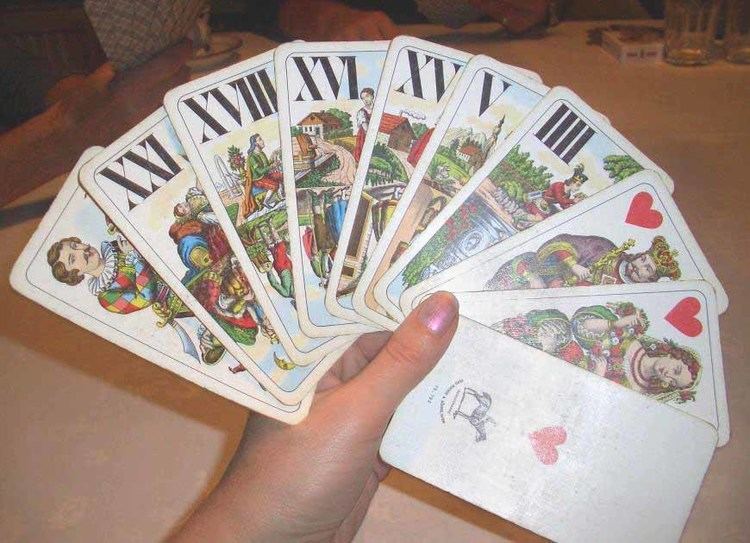Origin Austria Players 3 Cards 54 | Type Trick-taking Skills required Tactics, Strategy Deck Industrie und Glück | |
 | ||
Tapp-Tarock (Viennese Tappen) is a three-player tarot card game which uses the 54-card Industrie und Glück deck. This is an introductory game for more complex tarock games like Cego or Königrufen. During the interwar period, it was the preferred card game of Viennese coffee houses. Even today Tapp-Tarock is played sporadically. The exact date when it appeared is not possible to identify, but it is likely to have been developed in Austria in the early 19th century. The oldest version was narrated in 1821.
Contents
Tapp is a term for the undealt cards in the middle of the table called the talon in other tarock games or stock, widow, kitty, or skat in other card games. Tappu or Tappä is another name for the Swiss tarot game of Troggu and the Stubaital game of Brixentaler Bauerntarock.
History
Tapp-Tarock is probably the oldest tarock variant in which four basic features of tarock are found together:
The conversion of the Sküs was completed, according to the tarot expert Michael Dummett, in Austria. In Troggu, the older Swiss tarot game, the Fool can function as the highest trump or as the excuse. The introduction of the Pagat Ultimo, according to card game historian John McLeod, is believed to have come from Trappola, which was widely played in Austria.
Cards
The game is played with the 54-card French suited Industrie und Glück deck. It includes 22 trumps numbered in Roman numerals with the exception of the highest, the Sküs. The second highest trump, the XXI, is known as the Mond while the lowest trump, I, is called the Pagat. The Sküs, Mond, and Pagat are together known as the Trull and are worth 5 points each. Other trumps are worth only 1 point.
The 32 plain suit cards consist of four courts: king, queen, knight and jack, along with four pip cards. The cards rank as follows:
Kings are worth 5 points, queens 4, knights 3, jacks 2, and the pips 1. Like score counting in other tarot games, 2 points are subtracted from each trick taken. There are 70 card points in a round so to win at least 36 points are needed. Other than card points there are bonus points as described below.
Preliminary round
In the preliminary round, the seating arrangement is determined by lot. Similarly, the first dealer is determined by lot. It is then played in turn. The first player to the dealer's right starts the next round.
Dealing
The dealer first sets out six cards face down on the table (the talon) and then assigns each player 16 cards (usually counterclockwise in sets of four cards).
Bidding
The right of the dealer players now opens up the auction to play. Each player must beat the bid or pass, anyone that passes can't bid again. The player that bids "solo" ends the auction. The winner of the auction is the "declarer" and plays alone against the other two players (the "defenders"). The bidding increments are as follows:
Contracts
The declarer can also announce a contract before play begins. Contracts pose greater risk because the defenders gain prior information but awards more bonus points if the declarer succeeds. Failure to fulfill a contract can be disastrous and can leave the declarer with negative points. The contracts that can be made:
Game Play
Play is counterclockwise starting with the declarer. Each player must follow suit. If void of that suit, a trump must be played. If void of that suit and trumps, any card can be played but won't win the trick.
Variations
There are many variations of Tapp-Tarock with the most common being Illustrated Tarock and Point-Tarock which add more complex rules in bidding and contracts.
